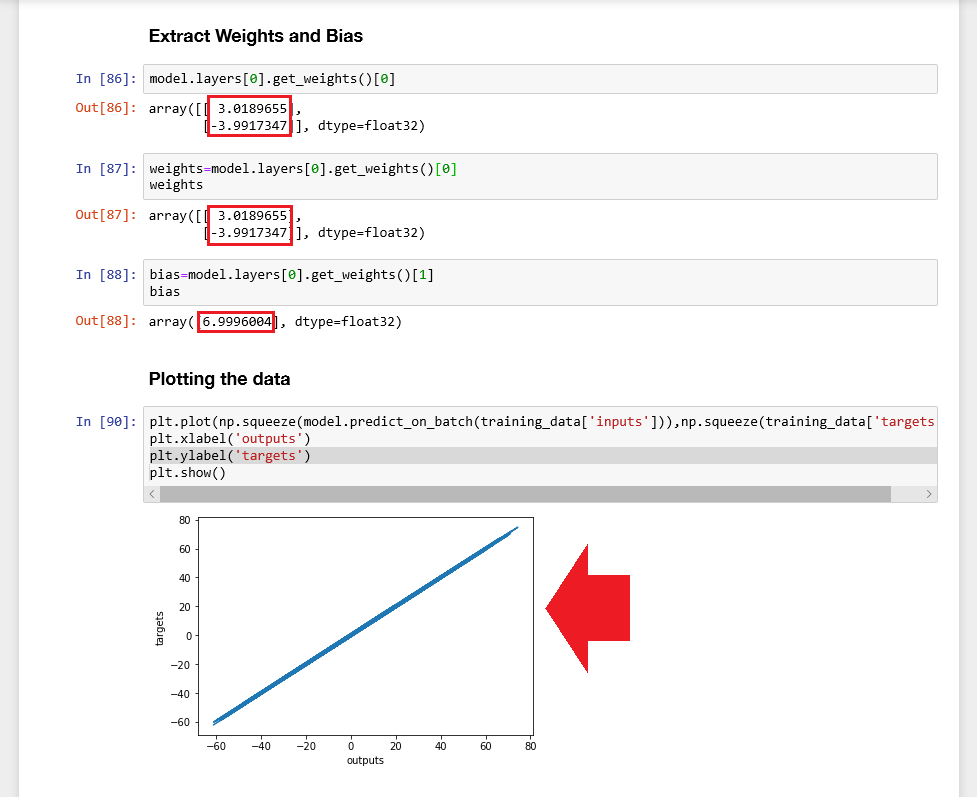Introduction to TensorFlow 2 Beta
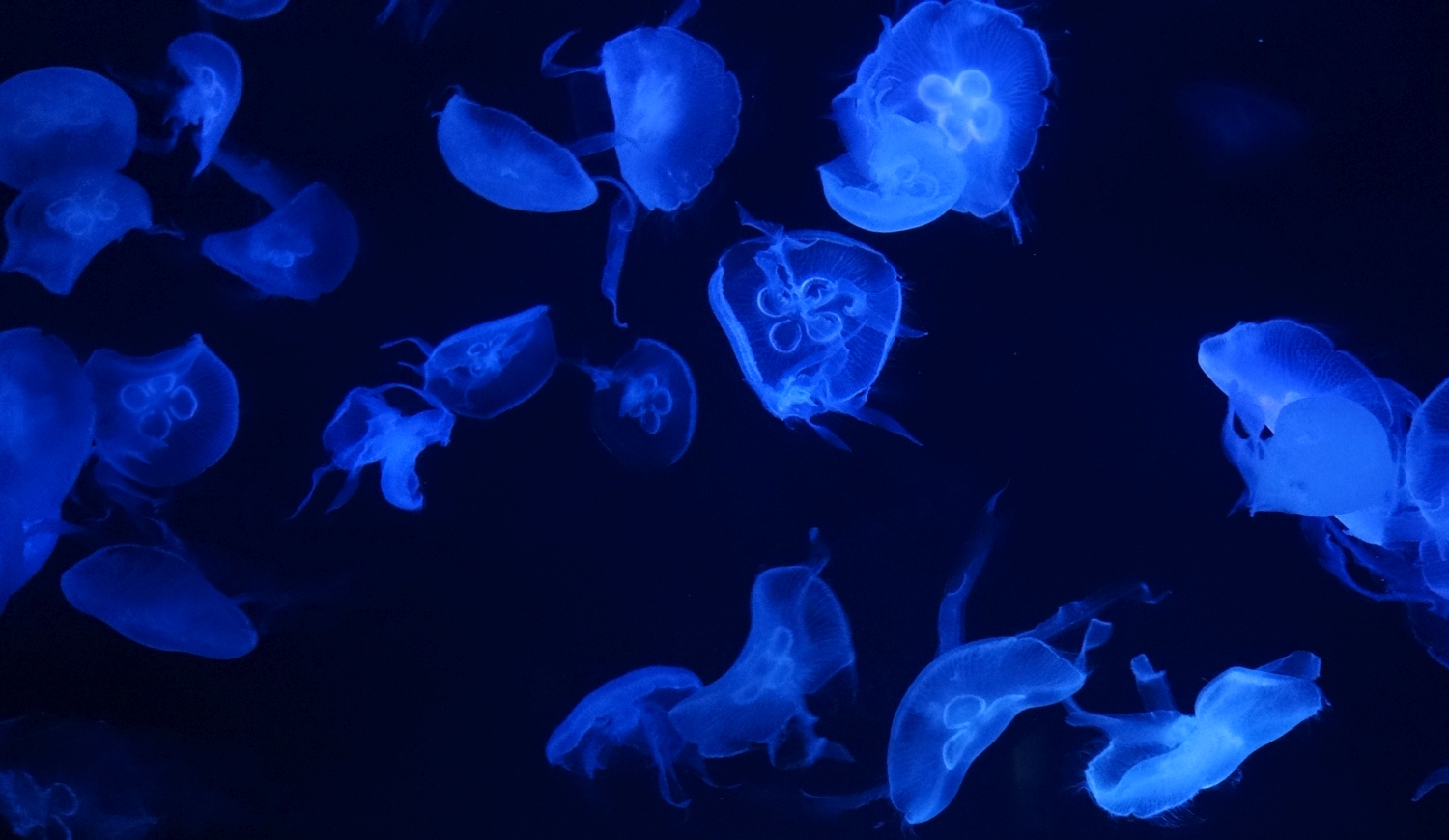
Installation of Tensorflow
You can install TensorFlow directly through pip3 install tensorflow or with GPU support pip3 install tensorflow-gpu (make sure you have Python v3 installed).
I have Anaconda set up on my computer and am going to use it for this instead. If you already have Anaconda installed, make sure that it is up to date (make sure that you start the Anaconda Prompt with Admin privileges):
conda update conda
conda update anaconda
Anaconda allows us to create a virtual environment in which we can run our TensorFlow program. To create the environment with the name py3-TF2 run the following command in the Anaconda Prompt - hit y when prompted:
conda create --name py3-TF2 python=3
conda activate py3-TF2
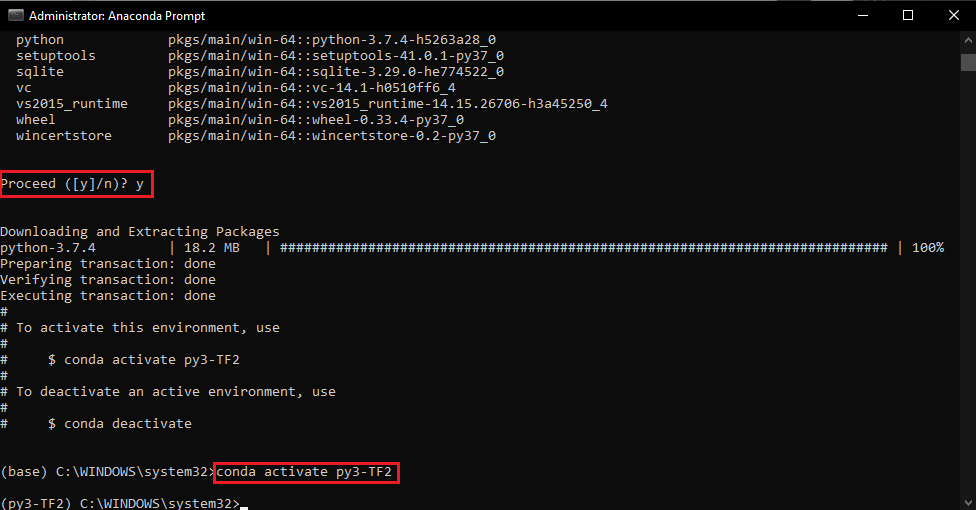
We can now continue installing TensorFlow inside this virtual environment. At the time of writing TensorFlow 2 is still in Beta and the exact version needs to be specified to prevent pip from using version 1 - please check the latest version before running the command below:
pip install tensorflow==2.0.0-beta1
To be able to use the virtual environment in Jupyter Notebook we need to install ipykernel and nb_conda_kernels inside it:
pip install ipykernel
conda install nb_conda_kernels
Open a new Python 3 project file inside Jupyter Notebook and verify that Tensorflow is up-and-running:
import tensorflow as tf
tf.__version__
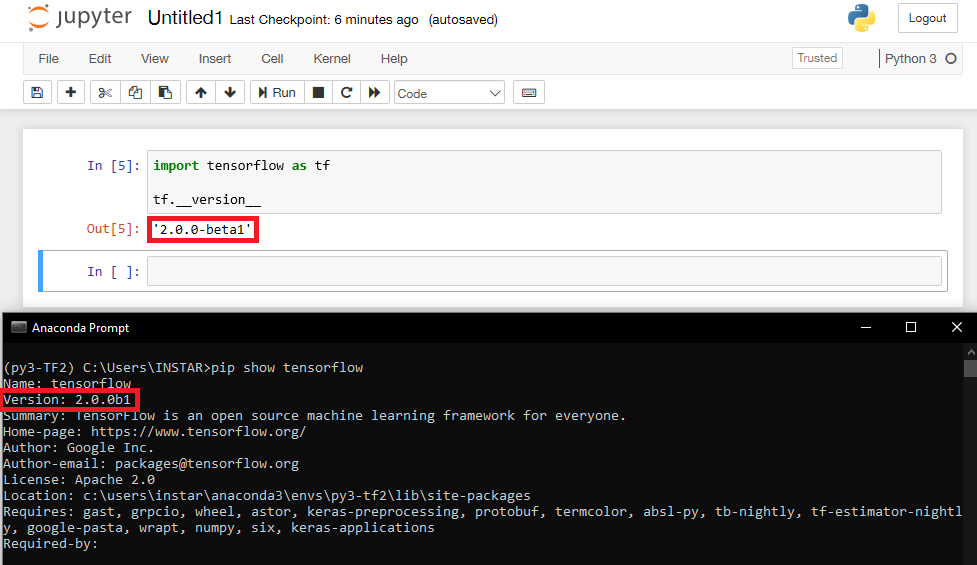
Your research environment is now ready for use!
Convolutional Neural Networks (CNNS)
- Classify an Image (e.g. a plane)
- Classify and Segment (getting the outline of an object - e.g. a plane - inside an image for further analysis)
- Recognize an Image (e.g. a Sukhoi SU-25T)
Underfitting: Our model has been trained on a data set that is too small. It can not be used to generalize or recognize. If our data set is too small we can use Transfer Learning to adapt a external model by retraining it's outer layer with our training data.
Overfitting: The model was trained with a very specific data set and reaches a high percentage in recognizing fits. But it fails to generalize and will only be useful with your specific sample data.
Picking a model
There are three different types of Machine Learning:
- Supervised Learning: We train our model with a set of labeled data before letting it have a go in the wild.
- Unsupervised Learning: The model trains itself with unlabeled data and splits the set into a given number of groups based on similarity. The groups can afterwards be labeled by us based on the goal we are persuing.
- Reinforced Learning: We let the model train unsupervised but add a reward system to make sure that the training goes into the direction we need it to go.
In the following we will concentrate on Supervised Learning.
Linear Model
The simplest model is always the Linear Model where we just have to feed the learning process a few x- and y-values and have it interpolate data points in between:
f(x) = xw + b
With x being the input, w the Weight and b the Bias for our model. Training the model would mean finding values for the weight and bias that the value of y - with a given set of values for x - comes as close to observed values as possible.
An example would be a model that calculates the rent for an apartment based on the size of the apartment:
rent = size * weight + bias
When we know more then one observation that would affect the prize of the apartment, we can simply add them up:
Rent = (Size*Weight) + (Proximity to Subway*Weight) - (Proximity to City Center*Weight) + Bias
To assess the quality of our linear model we can use the squard-loss (L2-norm) that weights the distance of each datapoint from the position it should have according to our model. The smaller the sum over all those distances the more accurate represents our model the give dataset.
Example: Simple Linear Regression
Creating the Model using Numpy
As an example we will create fake data with a linear relationship using numpy to help us to create and train a linear model. We will then use matplotlib and mplot3d to visualize the results we are getting:
observations = 1000
xs=np.random.uniform(low=-10, high=10, size=(observations,1))
zs=np.random.uniform(-10, 10,(observations,1))
inputs = np.column_stack((xs,zs))
Note that the size is defined by the number of observations times the number of variables for our linear function - here we only use one variable x or z. The resulting matrix inputs consits of 2 columns each holding 1000 random values.
We now need to create a target for our algorithm - a function that our model should find given the random but linear dataset, e.g.:
f(x,y) = 3x - 4z + 7 + noise
The weights 3 and 4 as well as the bias 7 are randomly chosen and the noise is again generated using Numpy:
noise=np.random.uniform(-1,1,(observations,1))
targets = 3*xs - 4*zs + 7 noise
We can now plot this data and will receive a plane inside a threedimensional space:
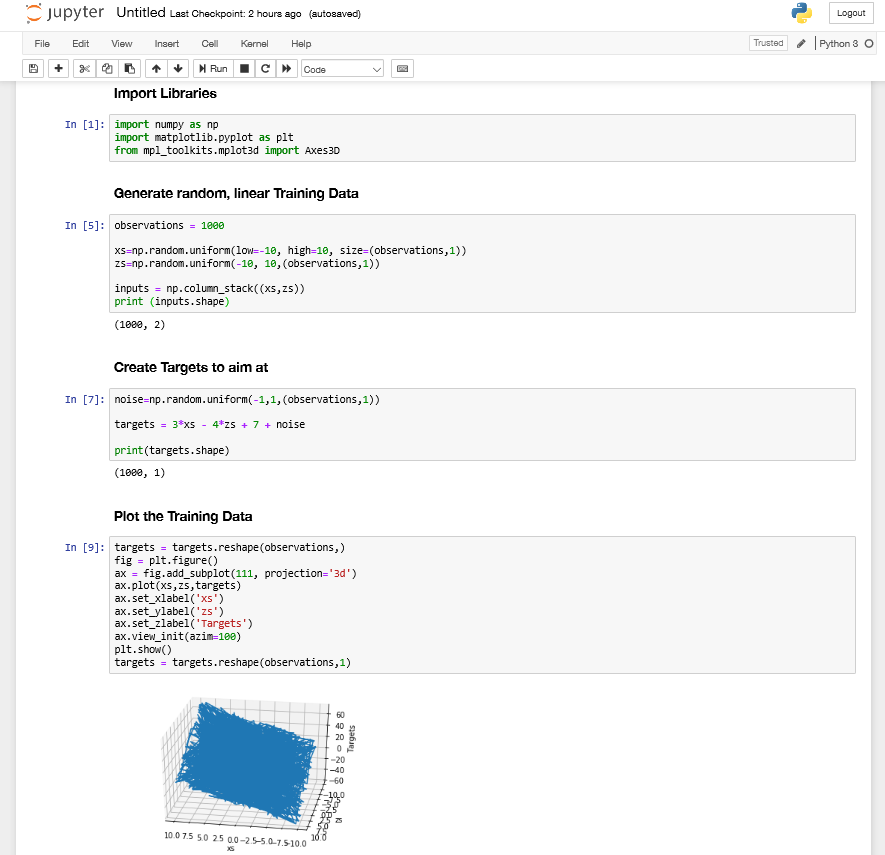
We can now set an initial range for the algorithm to pick weights and biases from at random to find a good fit:
init_range=0.1
weights=np.random.uniform(-init_range,init_range,size=(2,1))
biases=np.random.uniform(-init_range,init_range,size=1)
In this example our initial weights and biases will be picked randomly from the interval [-0.1,0.1].
Last preparation needed is setting a learning rate - the smaller the number, the smaller the increments that are used by the learning algorithm. This will lead to a more accurate value but will slow the algorithm down. In the example we will set the learning rate to a value of:
learning_rate = 0.02
Training the Model
We now can use a for loop to iterate through our data (in TensorFLow 1 iteration is called an Epoch, see further down), calculate outputs and compare them to targets using the loss function. Every interation should refine the weights and biases of our model and minimize the result of the loss function for the next run.
for i in range (100):
outputs=np.dot(inputs,weights)+biases
deltas=outputs-targets
loss=np.sum(deltas**2)/2/observations
print(loss)
deltas_scaled=deltas/observations
weights = weights-learning_rate*np.dot(inputs.T,deltas_scaled)
biases = biases-learning_rate*np.sum(deltas_scaled)
This function runs 100-times, optimizing the value for our weights and biases with each run. Printing the result of the loss function shows us a smaller value with each run:
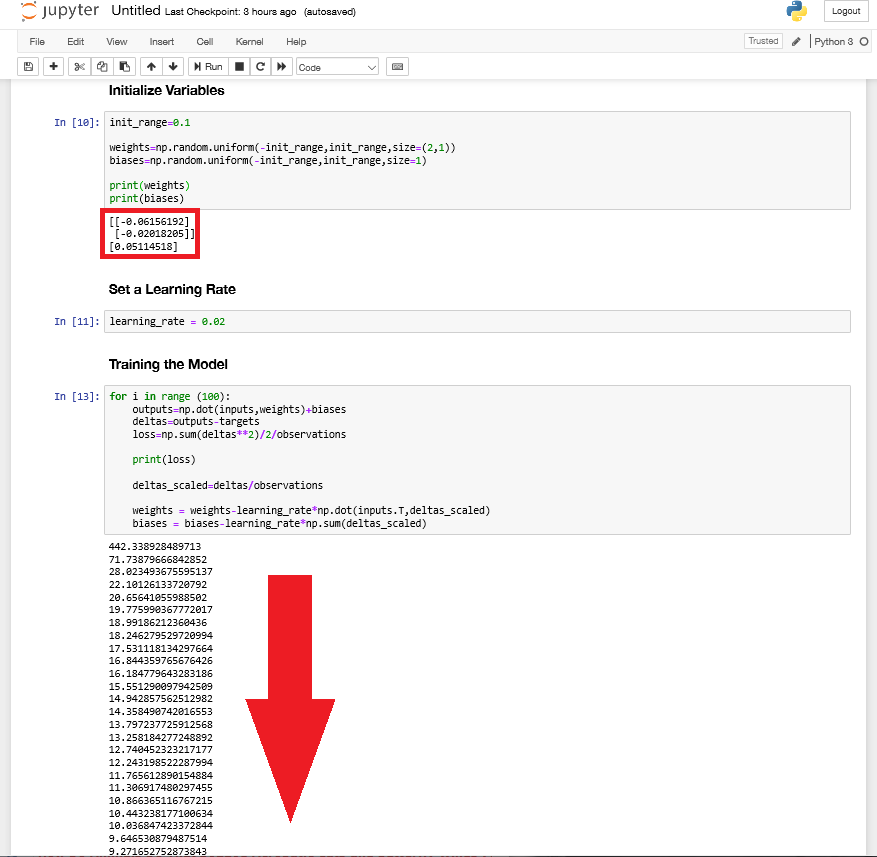
In the initialization step we can see that the algorithm starts out with the following weights and biases:
print(weights)
print(biases)
[[-0.06156192]
[-0.02018205]]
[0.05114518]
After running training the algorithm with 100 iterations those values change to:
print(weights,biases)
[[ 3.00537904]
[-4.00032605]] [6.06949437]

This is already very close to our target of 3&4 and 7 - but not close enough yet. We can increase the number of iterations in the learning step to improve the outcome. Or simply rerun the training step to add another 100 iterations:
print(weights,biases)
[[ 3.00076145]
[-4.00183613]] [6.86818993]

Plotting the Outputs of our Model against the Target value shows us a linear function at an angle close to 45 degrees. Our model, almost perfectly, represents the training data:
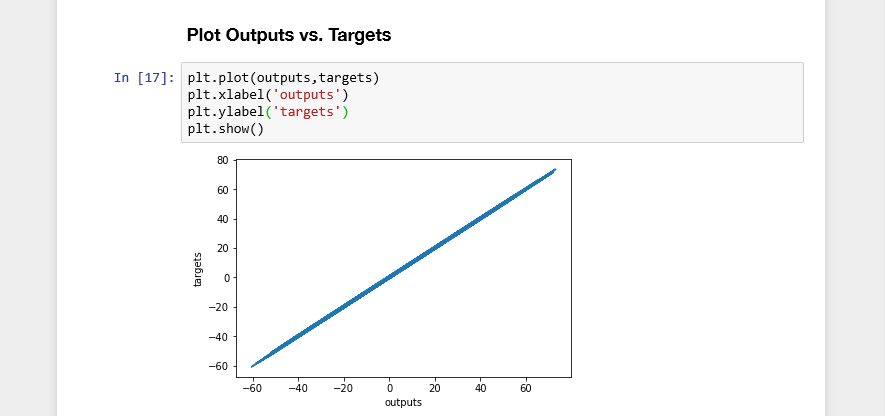
Introduction to TensorFlow
We can start by creating the same dataset as before only this time we will store the generated test dataset in a file format that supports storage of tensor data (n-dimensional arrays) (.npz) with the help of Numpy:
import numpy as np
import matplotlib.pyplot as plt
import tensorflow as tf
observations = 1000
xs = np.random.uniform(low=-10, high=10, size=(observations,1))
zs = np.random.uniform(-10, 10, (observations,1))
generated_inputs = np.column_stack((xs,zs))
noise = np.random.uniform(-1, 1, (observations,1))
generated_targets = 3*xs - 4*zs + 7 + noise
np.savez('tf-model-data-example', inputs=generated_inputs, targets=generated_targets)
Running this code will create a file tf-model-data-example.npz that holds our training data.
In the next step we can load this data set with Numpy and use a Keras function to calculate the output (y) of our function (output=np.dot(input,weights)+bias):
training_data=np.load('tf_model_data_example.npz')
input_size=2
output_size=1
model=tf.keras.Sequential([
tf.keras.layers.Dense(output_size)
])
model.compile(optimizer='sgd',loss='mean_squared_error' )
model.fit(training_data['inputs'],training_data['targets'],epochs=100,verbose=2)
You can display the Weights and Bias using the following code:
weights=model.layers[0].get_weights()[0]
bias=model.layers[0].get_weights()[1]
weights
bias
Those values should now be close to our target as defined above targets = 3*xs - 4*zs + 7 + noise - Weights 3 & -4 and 7 as the Bias.
Making Predictions
We can now use our model to make predictions model.predict_on_batch(data) for output values:
model.predict_on_batch(training_data['inputs'])
This will show you the outputs that have been calculated for the training data and previously compared to the target values to calculate the loss function.
Plotting those values against the targets will again result in a line graph close to a 45 degrees angle:
plt.plot(np.squeeze(model.predict_on_batch(training_data['inputs'])),np.squeeze(training_data['targets']))
plt.xlabel('outputs')
plt.ylabel('targets')
plt.show()
Customizing your Model
In the Numpy model earlier we set an initial range (init_range=0.1) to define the step size between epochs. But with TensorFlow we left everything at it's default, letting Keras choose for us - let's take control.
Adding Initializers
Here is how you add kernel and bias initializers to tf.keras.layers.Dense(output_size, kernel_initializer, bias_initializer):
model=tf.keras.Sequential([
tf.keras.layers.Dense(
output_size,
kernel_initializer=tf.random_uniform_initializer(minval=-0.1, maxval=0.1),
bias_initializer=tf.random_uniform_initializer(minval=-0.1, maxval=0.1)
)
])
Setting the Learning rate
We can also set the learning rate for our model, which in our Numpy model we defined with learning_rate = 0.02. In TensorFlow this is done by customizing the optimizer - we choose the SGD optimizer (Stochastic Gradient Descent optimizer) that supports a couple of modifiers, including the Learning Rate, Momentum, Decay, etc.
custom_optimizer=tf.keras.optimizers.SGD(learning_rate=0.02)
model.compile(optimizer=custom_optimizer,loss='mean_squared_error' )
